Battle of Cannae
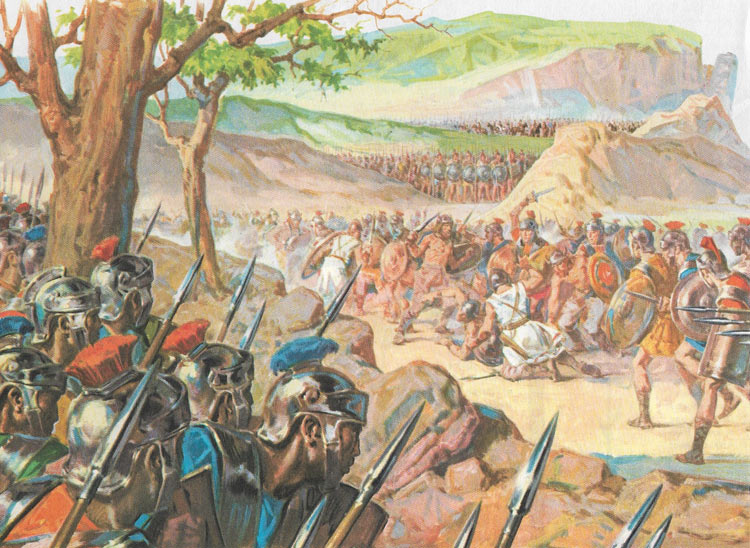
The second stage of the Battle of Cannae (see diagrams below. From the foreground to the background: on theleft, African infantry, wearing captured Roman armor; the Gallic and Spanish, center being forced back by the Romans; the other contingent of African infantry; and, in the distance, the Gallic and Spanish cavalry.
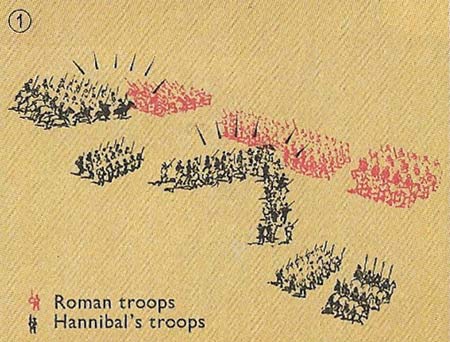
The Roman infantry attack, driving back the Gallic and Spanish infantry, while Hannibal's Gallic and Spanish cavalry on the left attack the Roman citizen cavalry.
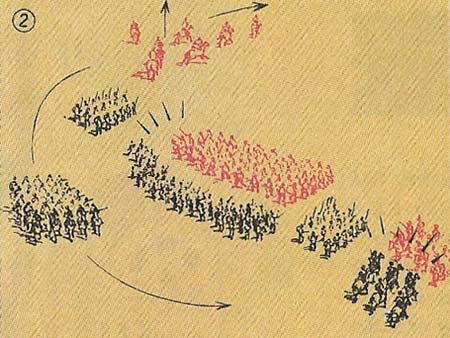
Hannibal's center withdraws farther; on the left his cavalry routs the Romans. A detachment moves to reinforce his African cavalry who are engaged on the right.
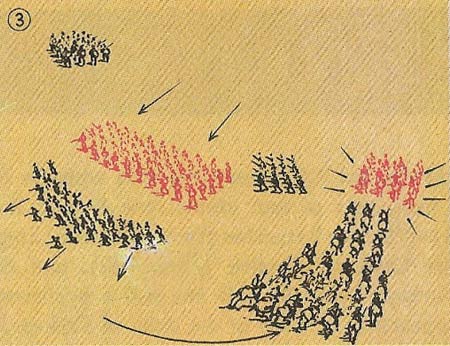
Hannibal's African infantry is now on the flanks of the advancing Romans. Meanwhile his reinforced African cavalry on the right wing attacks the Roman allies' cavalry.
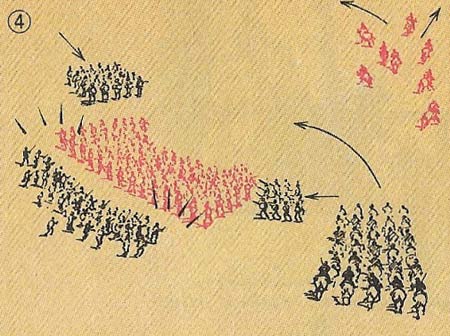
Hannibal's center is hard pressed, but his fresh African infantry attacks the advancing Romans on the flanks; his victorious cavalry wheels to attack them in the rear.
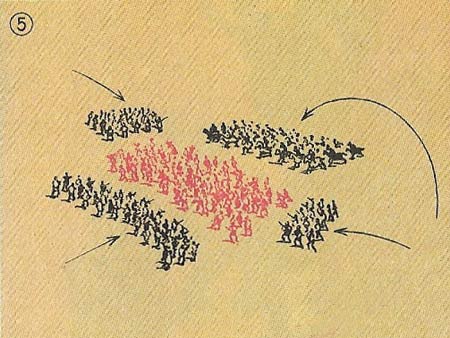
The Romans cavalry is nowhere to be seen. The Roman infantry is completely surrounded: it fights bravely for some time, but its defeat is now inevitable.
Imagine the 'special correspondent' of a newspaper of 216 BC giving an account of the great battle fought on the plain near Cannae, in Apulia.
GREAT ROMAN DEFEAT; 50,000 KILLED
WILL HANNIBAL MARCH ON ROME?
Cannae, 2nd August
"The attempt of the new consuls, L. Aemilius Paullus and C. Terentius Varro, to remove the Carthaginian menace has ended disastrously. Today at Cannae, Hannibal, the undefeated Carthaginian leader, won yet another victory over the forces of Rome. Though alone and isolated with his army, he seems to control all Italy. And Rome is facing destruction. 44,000 of her army have been killed, as well as 80 senators and the consul, Paullus. Will Hannibal take this opportunity to march on Rome? The fate not only of Italy but of all the Mediterranean world seems now to be in his hands. Hannibal was fortunate to be faced by a disunited opposition. The consuls had on alternate days. Varro was in command today, and may have to take more than his fair share of blame for the Roman defeat."
The Roman army had been increased to some 48,000 infantry. Hannibal had only 35,000 infantry, half of whom were not African but Spanish and Gallic allies. But he had 10,000 cavalry- at least 4,000 more than the Romans.
Varro massed his infantry in deeper files than usual, hoping their superior numbers would enable them to break through Hannibal's infantry. He drew up his allied cavalry on his left wing, and his few Roman citizen cavalry on his right.
Hannibal placed both his Spanish and his Gallic cavalry on his left wing (facing the weak Roman right wing), and only the African cavalry on his right. In te center he drew up his Gallic and Spanish infantry in a wedge-shaped formation. He kept his best troops, his veterans from Africa, in reserve on either side of the center, but held way back. One proof of their prowess was that, unlike the half-naked Gauls, they were all wearing Roman armor, spoils of their earlier victories. Hannibal chose the battleground with great care. When the Romans advanced to attack him, they had the morning sun in their eyes and a strong wind blowing dust in their faces.
The battle in diagrams
Refer to the accompanying diagrams.The Roman infantry attack, driving back the Gallic and Spanish infantry, while Hannibal's Gallic and Spanish cavalry on the left attack the Roman citizen cavalry.
Hannibal's center withdraws farther; on the left his cavalry routs the Romans. A detachment moves to reinforce his African cavalry who are engaged on the right.
Hannibal's African infantry is now on the flanks of the advancing Romans. Meanwhile his reinforced African cavalry on the right wing attacks the Roman allies' cavalry.
Hannibal's center is hard pressed, but his fresh African infantry attacks the advancing Romans on the flanks; his victorious cavalry wheels to attack them in the rear.
The Romans cavalry is nowhere to be seen. The Roman infantry is completely surrounded: it fights bravely for some time, but its defeat is now inevitable.
What now?
Roman casualties have been very serious indeed. Varro is believed to have escaped; but Aemmilius Paullus has been killed, together with 80 senators. Of the whole Roman army, barely 10,000 can have escaped. Total Carthaginian losses are said to be a mere 6,700.
Postscript
Hannibal did not march at once on Rome. Many Greek cities in southern Italy joined him, although central Italy stood firm. But the Romans never again dared to fight a pitched battle with him in Italy. The war lasted another 14 years. Eventually Hannibal was recalled to defend Carthage against the Roman general Scipio Africanus.
The second stage of the battle of Cannae. From the foreground to the background: on the left, African infantry, wearing, captured Roman armour; the Gallic and Spanish center being forced back by the Romans; the other contingent of African infantry; and, in the distance, the Gallic and Spanish cavalry.
